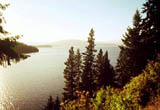


Driving across the country I still play the childhood game of looking for rare license plates. Of all the states, none appears more seldom than Idaho. I’ve seen plates from Alaska and even Hawaii more often than from Idaho; it’s as if something about the environment breeds people who stay close to home. “There is no stranger destination,” writes Marilynne Robinson, than Idaho, “nor odder origin.” Each year people ask me where I spend the summer. I say “Idaho,” and I can tell by the emptiness of their faces that my answer put them in a state of social uneasiness. To tell an Easterner you’re planning a trip to Idaho is to strain the rules of etiquette. There’s never a comfortable response. It goes beyond mere puzzlement. Sometimes I can see them weighing what they know about me against what they have heard on television about Richard Butler and the Aryan Nation. Then, in an effort to fill the awkward silence, they ask whether I have relatives in northern Idaho, or they make a joke about potatoes. Other times they misconstrue “Idaho” for “Iowa.” This happens more often than you would think possible, and then they tell me about their cousin in Des Moines or the time they drove with their kids through the midwest. Or sometimes they just look at me with a genial inquisitorial stare, the way you imagine Jane Goodall contemplating the behavior of a mountain ape.
Even in an age when everybody is wired to everybody and everything else, Idaho remains elusive. The name itself is a trap for the unwary. “Idaho,” according to widespread myth, comes from native American dialect, “Ee-da-how.” This means, I was taught as a child, “light on the mountain” or “the sun comes down the mountain.” Truth is, that story, like the story about Eskimos having dozens of separate words for “snow,” is fiction. The Inuit have no more than the usual number of words that occur in most Indo-European languages to refer to the different varieties of frozen precipitation, and “Idaho” doesn’t approximate any known native American word. It doesn’t mean what we think it means. In fact, it probably doesn’t mean anything at all. It’s most likely a coined word, a polysyllabic assembly made up a long time ago by some unknown promoter who wanted a name that would sound romantic to a population who dreamed of striking it rich in the West. “Idaho” is to the states of America as “Haagen-Daz” is to brands of ice cream. Both names are empty, meaningless sets of sounds invented to impress a gullible public. In this way it mimics the history of much of the West. When, in 1803, on the eve of the sale of the vast amount of land that was then called simply “Louisiana,” Napoleon was asked by his minister Talleyrand exactly what he should tell the Americans they were about to purchase, the emperor responded that “If an obscurity did not already exist, it would perhaps be good policy to put one there.” Talleyrand obediently reported to the Americans that “they should construe it [Louisiana] in their own way.”
If Idaho is hard to fix in the mind, it’s even harder to come to a clear opinion about it. Much of the popular press about Idaho isn’t good. Dave Barry in his columns regularly makes fun of it, and in the minds of a hundred million Americans right now, it’s the place where white separatists have their hideouts. Idaho is the place where Richard Butler located his national socialist church, and it’s the place to which Mark Furman retired after being disgraced during the trial of O. J. Simpson.
My experience of north Idaho is different What sets Idaho apart is not its atavism but its openness to change and to difference. If I had to sum up its ethos I would say this: it’s a place where an amazing tolerance extends to every person. In Idaho, your background doesn’t count for a whole lot; here you’re liked or not depending on what you say and do starting from the time you arrive. Many times in the days when I had a beard I met with long time residents of Benewah County who professed to dislike “hippies,” which to them apparently meant anyone alien, young, and hairy. Yet in spite of the fact that I looked exactly like the sort of person their televisions had taught them to be afraid of, I was always welcomed warmly into their houses. They talked to me, they sometimes fed me, they always gave me their best advice. Hippies for the locals were always somebody other than the person they were talking to.
It’s a place that in many ways is the place where time stopped, where you can find, as Montanans like to advertise about themselves, the last best place. But much of what is good about the state results not from its spectacular geography but from its emptiness. People are still relatively few in number in Idaho, and apart from Boise there’s nothing that can claim the title “city.” In 1990, the census counted barely half of the state’s population as living in towns with populations greater than 2,500. Idaho is still isolated ranches and small towns, and with those towns and ranches comes a hunger for companionship and a belief that simple human contact is the pearl beyond price. I still remember the day in 1974 I received by mail a license place for my truck. This was in the days before private citizens could choose to lower their plate numbers in indirect relationship to the size of their individual egos. The number on my plate was unbelievable: 67.
That number on my license plate was a constant reminder of the relative sparsity of humans in Idaho; all my neighbors had numbers like that. It made for an odd sight in parking lots and along side streets in St. Maries; the lineup of license plates made me think I’d stumbled onto a convention of big shots: 50 was parked next to 35 next to 122. And in a way I had: since then, the closest I’ve come to something like it is the row of cars at Emory University Hospital in the spaces reserved for hospital administrators and chiefs of surgery (although their cars are a little more upscale than you’d have seen parked in front of the IGA in St. Maries in 1975). Those memorable numbers were an affirmation of their owners’ place in the order of things. And with that affirmation of identity came social responsibility. Here was a place where people could not escape their neighbors and so could not escape themselves.
Next > > > “Idaho remains stubbornly incomprehensible . . . ”